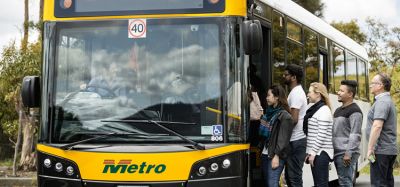Advancing technology: friend or foe?
- Like
- Digg
- Del
- Tumblr
- VKontakte
- Buffer
- Love This
- Odnoklassniki
- Meneame
- Blogger
- Amazon
- Yahoo Mail
- Gmail
- AOL
- Newsvine
- HackerNews
- Evernote
- MySpace
- Mail.ru
- Viadeo
- Line
- Comments
- Yummly
- SMS
- Viber
- Telegram
- Subscribe
- Skype
- Facebook Messenger
- Kakao
- LiveJournal
- Yammer
- Edgar
- Fintel
- Mix
- Instapaper
- Copy Link
Posted: 19 October 2017 | David Leininger | No comments yet
Mobile technology, advances in autonomous vehicles and the emergence of so-called transportation network companies (TNCs) pose wonderful opportunities but also real existential threats, so which is it? David Leininger, Executive Vice President, Chief Financial Officer, Dallas Area Rapid Transit (DART), discusses the current and emerging trends in ticketing and mobility, reflecting on possibilities for the future of mass transit and how transport authorities must embrace them.


THE answer to the question ‘friend or foe?’ in this instance should be ‘neither’. It would be a very naïve person who would believe that the TNCs have the interests of the public transit agency as a first priority. These new players are clearly disruptive innovators and have demonstrated a willingness to ignore local regulations and public policies that impede their ability to grow their business. They are taking real market share from the traditional taxi industry and, in some markets, from public transit providers.
However, these companies are not yet profitable, and dropouts have already occurred, which means they may be running a little scared and might operate with sharp elbows. However, customers love their services because they are easy to use, serve their purpose, and are reasonably priced – at least for now.
We are certainly in the early stages of a seismic shift in the manner in which mobility services are delivered and operated. It is obvious that many parties are seeking to develop highly integrated mobile ticketing and trip-planning apps providing seamless, multimodal, multi-operator trip planning and billing. These improved platforms will encourage even more experimentation and most likely incent additional types of mobility operators to join these new platforms.
With regard to autonomous vehicles, we have yet to see the impact of their widespread, commercial use and thus we do not really know how public transit agencies will be affected. Will public agencies own large fleets to replace existing bus fleets? Will individual ‘pod cars’ be widely deployed to provide first- and last-mile trips to transit facilities or, rather, will they take riders to their ultimate destination? Will public transit agencies create their own versions of Uber and Lyft, enrolling drivers and riders directly?
Or, will public transit agencies not participate at all in these emerging trends, and consequently witness large reductions in discretionary riders, thus rendering the agencies as providers of a last resort, serving largely the low income, transit-dependent riders?
Another possibility is for public transit to be totally outsourced to TNCs, as has already happened in some small, suburban communities. In this event, assuming the TNCs serve all riders, should this be considered a bad thing?
A mobile-led future
A great deal of creative work has emerged in the area of mobile ticketing. Integrated mobile platforms are under development for micro-transit shuttles, intelligent, ‘Uber-like’ carpooling, bike-sharing, as well as versions of apps that permit public transit agencies to offer their own version of ridesharing integration. The goal of these initiatives is to integrate payment in a single app with one transaction to the customer and back-end settlement to the service providers, including the public transit agency.
By way of example, the United States Federal Transit Agency (FTA) Sandbox Grant Program is facilitating an industry-wide appreciation of the possibilities available with regard to mobility on demand. Every agency should obtain access to the reports coming from this effort. Among other things, the Sandbox Program also illustrates how quickly sophisticated app-based mobility solutions can be defined and deployed.
To illustrate how quickly things are moving, DART has been able to bring together five technology providers (Unwire, VIX, DoubleMap, Spare Labs and MJM) for a four day ‘hackathon’ to test integration possibilities, and aims to deliver a fully integrated mobile app solution within 12 months. The phrase ‘speed to market’ does in fact apply to public transit.
To gain insight into the future of mobility, look at MaaS Global and review their Whim app for Helsinki, Finland to see a real-world offering. This implementation illustrates the broad range of mobility options that can be integrated in a Mobility-as-a-Service offering.
One of the early innovators in this arena was Ben Whitaker, co-Founder of Masabi. He explains: “My belief is that TNCs and autonomy will have greatest effect in lower population density cities/ areas, and that high-density cities will still be mostly about mass transit solutions, but with much greater TNC/autonomous integration as they hand over to lower density areas, reducing the running of under-optimised buses in those areas.”
DART selected a different provider; Unwire of Copenhagen. DART is pursuing a comprehensive integration of mobile payment among mobility providers, but I share Ben Whitaker’s view on the direction in which this seems to be headed.
Other mobile providers, such as moovel, Bytemark and Passport, are pursuing integrated mobility platforms as well. They are all expanding well beyond mere ticketing, for the simple reason that their platforms lend themselves to innovation.
Making the vision a reality
With regard to the new comprehensive payment platforms that are being delivered in public transit, the concept of a single system integrator falls apart. Contemporary payment platforms need to integrate mobile payment apps, retail gift card networks, open architecture rail platform and bus electronic validation equipment, account-based backend systems accommodating real-time transaction and multi-provider settlement and seamless integration with the agency’s financial systems.
If one devotes some time to evaluating the capabilities of the vendors and suppliers serving this area it becomes obvious there is no single vendor offering all of these capabilities. Moreover, it is not even helpful for them to try because post-deployment the agency will find the need to be able to directly interact on a regular basis with the manager of the retail card network, separately with the mobile ticketing app provider, as well as the provider of fareboxes, TVMs and validators.
The current best solution clearly depends on the in-house capabilities of the agency. Smaller agencies may be forced to outsource the programme management to a third party who acts as agent for the agency, but is not the contractor for any system or subsystem. Larger agencies should be able to manage the task in-house, assuming they are empowered to assemble cross functional teams to participate in system definition, deployment and customer engagement.
Public transit agencies will either embrace the emerging mobility environment or risk being relegated to the dustbin of history.
At the present time the extent of market share shifting away from public transit to alternative mobility providers is relatively modest. Obviously, the taxi industry is the exception in this respect and has already been heavily impacted. If Ben Whitaker and others are correct, public transit may soon encounter serious decreases in local bus route ridership as better options become available to get the rider to rail and express bus routes. The implications of such a shift in terms of lost revenue and rapidly changing bus fleet requirements are rather startling.
Gary Thomas, Chief Executive of DART, routinely points out that public transit agencies either embrace mobility in its broadest forms, or risk the fate of Polaroid or Kodak. The introduction of the automobile spelled the demise of ubiquitous streetcar systems in urban areas of the United States and sharply diminished the sustainability of the local bus service. It could happen again if public transit agencies are unable to adapt, though this time, it could happen even faster.
Biography


Related topics
Ticketing & Payments
Issue
IT Issue 1 2017
Related cities
United States of America
Related organisations
Dallas Area Rapid Transit (DART)
Related people
David Leininger








